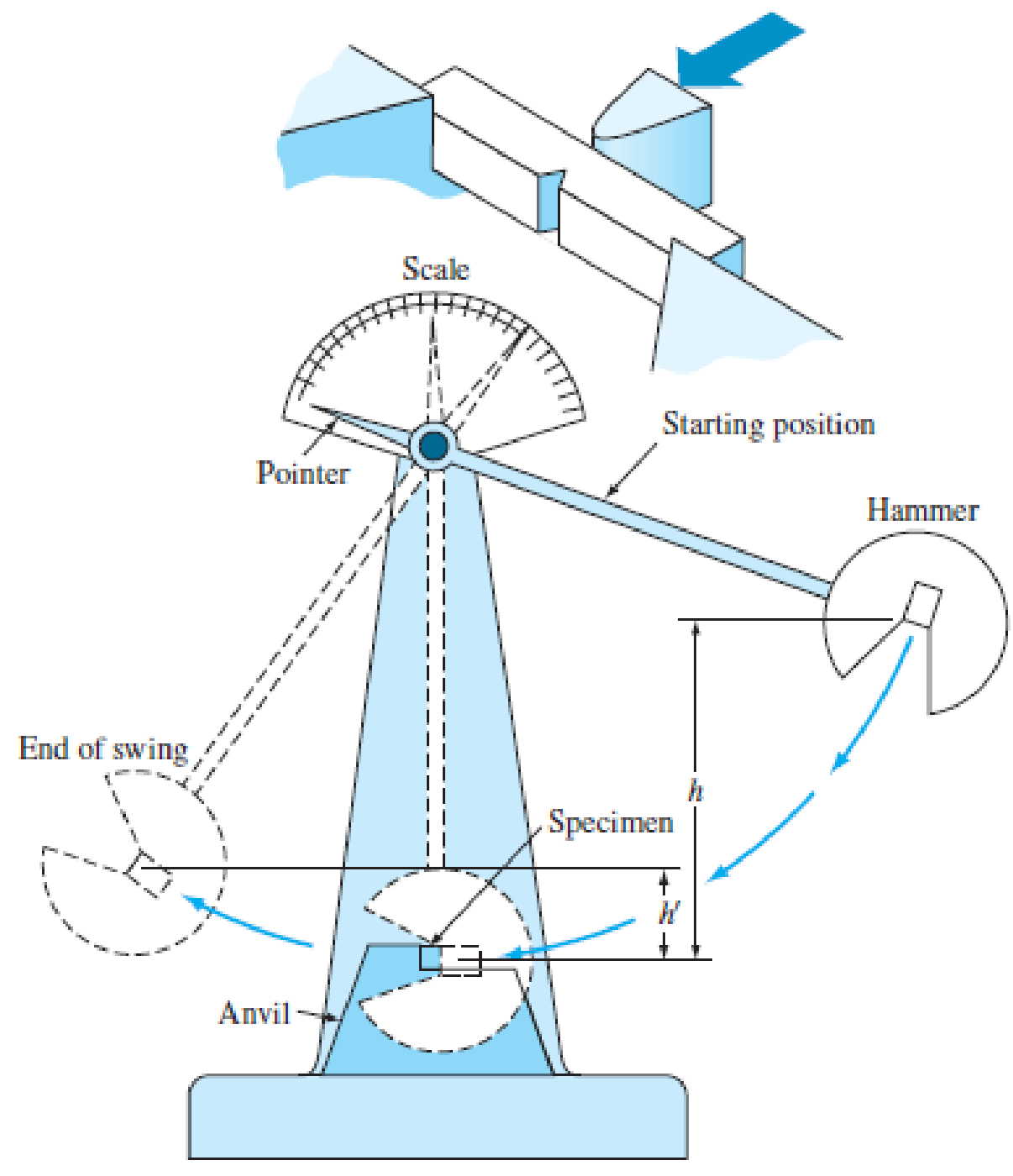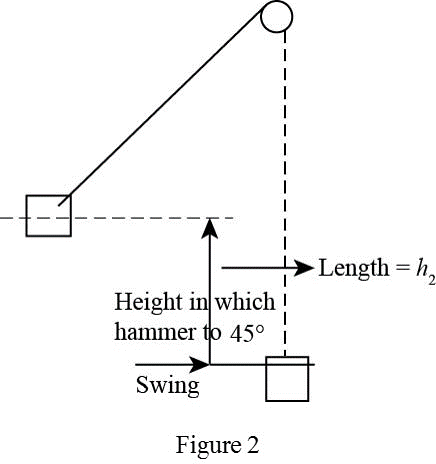
Concept explainers
A Charpy V-notch specimen is tested by the impact-testing machine in Figure 7.9. In the test, the 10 kg hammer of arm-length 110 cm (measured from the fulcrum to the point of impact) is raised to 80° and then released. (a) What is the potential energy stored in the mass at this point? (b) After fracture of the specimen, the hammer swings to 45°. What is the potential energy at this point? (c) How much energy was expended in the fracture of the specimen? Hint: potential energy = mass × g × height.

Figure 7.9
Schematic drawing of a standard impact-testing apparatus.
(a)
The potential energy stored in the mass at the point of impact when the hammer raised to
Answer to Problem 43SEP
The potential energy stored in the mass at the point of impact is
Explanation of Solution
Write the expression for Potential energy stored in the hammer is,
Here, mass of hammer is
Conclusion:
Below figure represent the new position of the hammer when hammer is raised to

From Figure-1, when the hammer is rotated to an angle of
Substitute
Thus, the potential energy stored in the mass at the point of impact is
(b)
The potential energy at the point of impact when the hammer swing to
Answer to Problem 43SEP
The potential energy stored in the mass at the point of impact is
Explanation of Solution
Write the expression height of impact when hammer is raised
Here, height of impact is
Write the expression for Potential energy stored in the hammer is,
Here, mass of hammer is
Conclusion:
Below figure represent the new position of the hammer when hammer is swing to

From Figure-2, when the hammer is swing to an angle of
Substitute
Substitute
Thus, the potential energy stored in the mass at the point of impact is
(c)
The amount of energy expended in the fracture of the specimen.
Answer to Problem 43SEP
The amount of energy expended in the fracture of the specimen is
Explanation of Solution
Write the expression of energy expended in the fracture of the specimen is,
Conclusion:
Substitute
The amount of energy expended in the fracture of the specimen is
Want to see more full solutions like this?
Chapter 7 Solutions
Foundations of Materials Science and Engineering
Additional Engineering Textbook Solutions
Vector Mechanics for Engineers: Statics, 11th Edition
Mechanics of Materials
Applied Fluid Mechanics (7th Edition)
Degarmo's Materials And Processes In Manufacturing
Applied Statics and Strength of Materials (6th Edition)
Engineering Mechanics: Dynamics (14th Edition)
- What is the importance of torsion test in real life especially in mechanical engineering field?arrow_forward2 m B specimen How did you find the air resistance for the impact test experiment?arrow_forwardA football (soccer) player can kick the ball with about 4 kN of force. Suppose an athlete accidentally kicks their competitor's tibia instead of the ball. This injury may be modeled by the diagram below, where the kick is represented by force F. Assume that the load is applied directly in the middle of the tibia. For the sake of simplicity, model the bone as a solid beam with 2 cm x 2 cm square cross-sectional area. Note that the pin and roller in the model do not induce reaction moments. Use E = 16 GPa. F = 500 N/cm 20 cm (a) Draw a free body diagram (FBD) including all external forces.arrow_forward
- If the mass of the string and the cup are so small that they are negligible, what is the approximate minimum number of 10-cent coins needed to break a bar of chocolate that has a flexural stress of 515,000 Pa? The length, thickness, and width measurements of the chocolate bar are 12mm each, and the mass of one 10-cent coin is 2.5g. Answer : zero, one, two or five?arrow_forwardExperiments were conducted in a tension testing machine to evaluate the material properties of two metallic rods both having diameter equal to 10 mm. First rod having modulus of rigidity of the material equal to 400 tonnes/cm2 when subjected to an axial tensile force of 6 kN, the change in its diameter was observed to be 0.0018 cm. The value for the bulk modulus of the second metallic rod is same as that of the first one but modulus of elasticity 18% more. Based on the material properties calculate and compare the values of different moduli as well as Poisson’s ratio for both metallic rods. Justify your answer with reasons.arrow_forwardQuestion-3: - Initial error of the impact tester is 2.5. Find the corrected energy absorbed in a metal specimen under impact load by a frictionless impact tester with impact Toughness 0.35J/mm2 specimen is 10 x 10 mm in section and 75 mm long having a standard 45°notch 2mm deep.arrow_forward
- Scenario. Three specimen of D12 rebar was subjected to a Tensile Test. Using a steel density of 8000Kg/cu.m. With the following result specimen 1 specimen 2 M=0.895 kg M=0.89 kg L=98 cm L=99 cm Load at yield strength= 5000 kg Load at ultimate =8600 kg Gauge length after test=21.5 cm Load at yield strength= 5000 kg Load at ultimate =8600 kg Gauge length after test=21.6 cm specimen 3 M=0.897 kg L=100 cm Load at yield strength= 5010 kg Load at ultimate strength=8590 kg Gauge length after test=21.6 cm specimen Yield strength Yield strength Ultimate strength Ultimate strength STRAIN based on actual based on 12mm based on actual based on 12mm diameter (MPa) diameter (MPa) diameter (MPa) diameter (MPa) 1. 2. averagearrow_forwardQ1/A structural part is 1-meter-long and subjected to a 50 KN load in which this part must be deformed elastically without experiencing any permanent deformation. If you know that part is made of steel, brass, aluminum, and Titanium alloys and the yield strengths and densities of these alloys are: 860 MPa, 7.9 g/cm³; 415 MPa, 8.5g/cm³; 310 MPa, 2.7 g/cm³; and 550 MPa, 4.5 g/cm³ respectively. Based on these criteria, rank the alloys from the heaviest to the lightest in weight.arrow_forwardThe data below are for a thin steel wire suitable for use as a guitar string. Ultimate tensile stress: 1.8 x 109 Pa Young Modulus: 2.2 x 1011 Pa Cross-sectional area: 2.0 x 10-7 m2 In a tensile test, a specimen of the wire, of original length 1.5 m, is stretched until it breaks. Assuming the wire obeys Hooke’s law throughout, calculate the extension of the specimen immediately before breaking.arrow_forward
- Which one of the following is the correct definition of ultimate tensile strength, as derived from the results of a tensile test on a metal specimen: O the stress encountered when the stress strain curve transforms from elastic to plastic behavior the maximum load divided by the final area of the specimen the maximum load divided by the original area of the specimen O the stress observed when the specimen finally failsarrow_forwardQ3b. The stress-strain characteristic curves for materials A, B and C are shown below. Which one statement most accurately describes the relative toughness and ductility for materials A, B & C? Material A Material B Material C Strain Select one: a. Material A has low toughness, Material B has high ductility and Material C has low toughness. b. Material A has high toughness, Material B has low ductility and Material C has low toughness. c. Material A has low ductility, Material B has low toughness and Material C has low toughness. d. Material A has high ductility, Material B has low toughness and Material C has high toughness. Stressarrow_forward3. One way of quantifying the energy needed to create fracture in a material is with a Charpy test, shown to the right. A large pendulum (here m= 50 kg, ka = 1.75 m) is released from rest 1.25 m when 0= 0°. The pendulum hits a notched sample of standard size of the material to be tested at S. The pendulum swings up the other side, with its angular distance measured by a ratcheted scale. The system is designed to minimize frictional losses, so the difference in the energy at release and the maximum energy in the follow through is the energy absorbed in fracturing the sample. For the Charpy apparatus shown, what is the angular velocity and kinetic energy of the pendulum the instant before it hits the sample at S when 0=90°.arrow_forward
 Elements Of ElectromagneticsMechanical EngineeringISBN:9780190698614Author:Sadiku, Matthew N. O.Publisher:Oxford University Press
Elements Of ElectromagneticsMechanical EngineeringISBN:9780190698614Author:Sadiku, Matthew N. O.Publisher:Oxford University Press Mechanics of Materials (10th Edition)Mechanical EngineeringISBN:9780134319650Author:Russell C. HibbelerPublisher:PEARSON
Mechanics of Materials (10th Edition)Mechanical EngineeringISBN:9780134319650Author:Russell C. HibbelerPublisher:PEARSON Thermodynamics: An Engineering ApproachMechanical EngineeringISBN:9781259822674Author:Yunus A. Cengel Dr., Michael A. BolesPublisher:McGraw-Hill Education
Thermodynamics: An Engineering ApproachMechanical EngineeringISBN:9781259822674Author:Yunus A. Cengel Dr., Michael A. BolesPublisher:McGraw-Hill Education Control Systems EngineeringMechanical EngineeringISBN:9781118170519Author:Norman S. NisePublisher:WILEY
Control Systems EngineeringMechanical EngineeringISBN:9781118170519Author:Norman S. NisePublisher:WILEY Mechanics of Materials (MindTap Course List)Mechanical EngineeringISBN:9781337093347Author:Barry J. Goodno, James M. GerePublisher:Cengage Learning
Mechanics of Materials (MindTap Course List)Mechanical EngineeringISBN:9781337093347Author:Barry J. Goodno, James M. GerePublisher:Cengage Learning Engineering Mechanics: StaticsMechanical EngineeringISBN:9781118807330Author:James L. Meriam, L. G. Kraige, J. N. BoltonPublisher:WILEY
Engineering Mechanics: StaticsMechanical EngineeringISBN:9781118807330Author:James L. Meriam, L. G. Kraige, J. N. BoltonPublisher:WILEY





